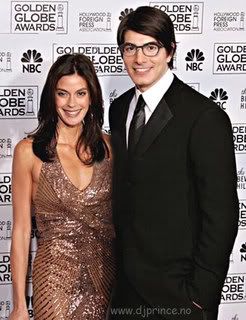 Act I — Margot Kidder
Act I — Margot KidderShe was the best-known Lois Lane in the history of the Superman franchise. She had all the trappings of stardom: she went to glamorous parties, she wore designer clothes, she had a much-publicized romance with a head of state, she married three talented men. It was, from the outside looking in, a fairy-tale life.
WAS. Past tense.
“That wasn’t me,” Margot Kidder says today. “That was someone else. I call her Margot Movie Star, and she was a lonely and unhappy person.”
“I never miss being ‘the celebrity,’’’ she adds. “Celebrity can be creepy. It makes you insecure and self-conscious.”
Her own encounters with the press corps during what she calls “the most famous nervous breakdown in history” give her sympathy for the stars currently being hounded for their personal crises. “All that media attention makes it hard to recover,” she says quietly.
Her breakdown changed everyone’s perception of her immediately, she says. “My career virtually ended, but I plowed through, which I consider a triumph.”
“People have a ludicrous obsession with celebrities and celebrity scandals. The press vultures hunted me down, even when I was staying in very secluded spots. They’d hide in bushes with long-lens cameras. Once when I was staying in a friend’s home outside Livingston, a National Enquirer reporter showed up in town and started nosing around, and some of my friends escorted him out of town.”
Home
It was perhaps partly having friends like that that drew Kidder back to Livingston to live. “I think I’ve spent most of my life figuring out where home was,” she says.
She grew up in “little Canadian mining camp towns” where she played with her siblings in the woods and on the skating rinks her father built for the family. “It was a wonderful childhood,” she says. “It was the kind of life that was portrayed on the covers of the Saturday Evening Post in the 1950s. In those communities, as long as you were a good person, that was what counted. Nobody cared about what phony status you might have,” she adds. “That’s the way Livingston is today. Here I’m not that different from anyone else, which is what I love.”
There’s the benefit of having her daughter, Maggie, and Maggie’s two children, Maisie and Charlie, living only a few blocks away from Kidder’s home, a spacious Frank Lloyd Wright “kit house,” which she calls “a perfect grandma house.”
It was Maggie, in fact, who brought Kidder back to Livingston after many years away.
“She was planning to get married and called me in Prague, where I was living at the time, and asked me to come and help plan the wedding. So I came back to Livingston, where Maggie had been born, and found I still had friends here, that it was really home.”
At that time, Kidder was a Canadian citizen, but two years ago she became an American. “Some of my family were horrified,” she says. “They accused me of joining the enemy!” “But,” she adds, “my father was an American, so the Kidder family secret was that they were ‘half and half’ all along.”
Maggie was born to Kidder and her first husband, author Thomas McGuane, who calls the McLeod area home. “We share grandparenting of two incredible grandchildren,” she says, adding that the close proximity has made it possible to “mend some fences” with the first of her three husbands. She was also married to actor John Heard and director Philippe de Broca.
“I was never good at male/female relationships, though God knows I try,” she says.
Her Life Today
Even though she says, “I’m 58 and my star rose long ago; that’s fine with me.” Most of her fans and friends would disagree with that assessment of her current life.
Professionally, Kidder has stayed active, both with the Superman franchise, playing Dr. Bridgette Crosby in two episodes of Smallville and, more recently, appearing in two 2007 episodes of Brothers and Sisters as Emily Craft, “best buddy” of Nora Walker, the Sally Field character. She says she hopes to reprise that role in the coming season because “doing guest spots is fun.”
“Hollywood is not kind to women aging,” she observes. “On that show, they’re very real; they let women in their 50s and 60s be themselves.”
She is currently making a film in Canada in which she plays the murderous mother of a young man. “She’s a wicked, wicked person,” she says with delight. “That’s more fun than playing someone nice and benign.”
She also spends time and energy on causes she cares about. She’s become an advocate for people with mental illnesses. She works with, and now co-chairs, Montana Women For, an organization formed to educate people on issues of the day. MWF has held forums on global warming, energy issues, Islam, sex education in Montana schools, and the war in Iraq—“all absolutely non-partisan,” she says.
For the Livingston 2005 Fourth of July parade, MWF’s entry featured 70 women in Lady Liberty outfits promoting peace. “We all danced on the back of a flatbed truck to the music of ’60’s peace songs,” Kidder says, “and we won the award for ‘Best Patriotic Float.’”
And, in 2006, the group put together a Mothers’ Day March in Bozeman, which attracted national attention and brought out thousands of marchers and spectators. It also introduced Kidder to Elsie Fox, a 99-year-old political activist from Miles City. “I think of Elsie as being Pure Montana,” she says, “and I love her philosophy: ‘Be politically active––you’ll live longer.’”
While she was performing in The Vagina Monologues, Kidder drove all around the country. “Every state has its own specific personality,” she says. “Montana’s is extraordinarily unique, a gentle personality. You can feel it everywhere, in its odd, rough-around-the edges way.”
Seeing her sitting in her backyard with her two dogs, Sadie and Pierre, surrounded by irises of many shades, one feels that “gentle personality” in the person of Margot Kidder.
“You know,” she says, “I’ve had a colorful life, and I have to live with that. But right now things are pretty darn good.”
Source: Distinctly Montana


























































































No comments:
Post a Comment